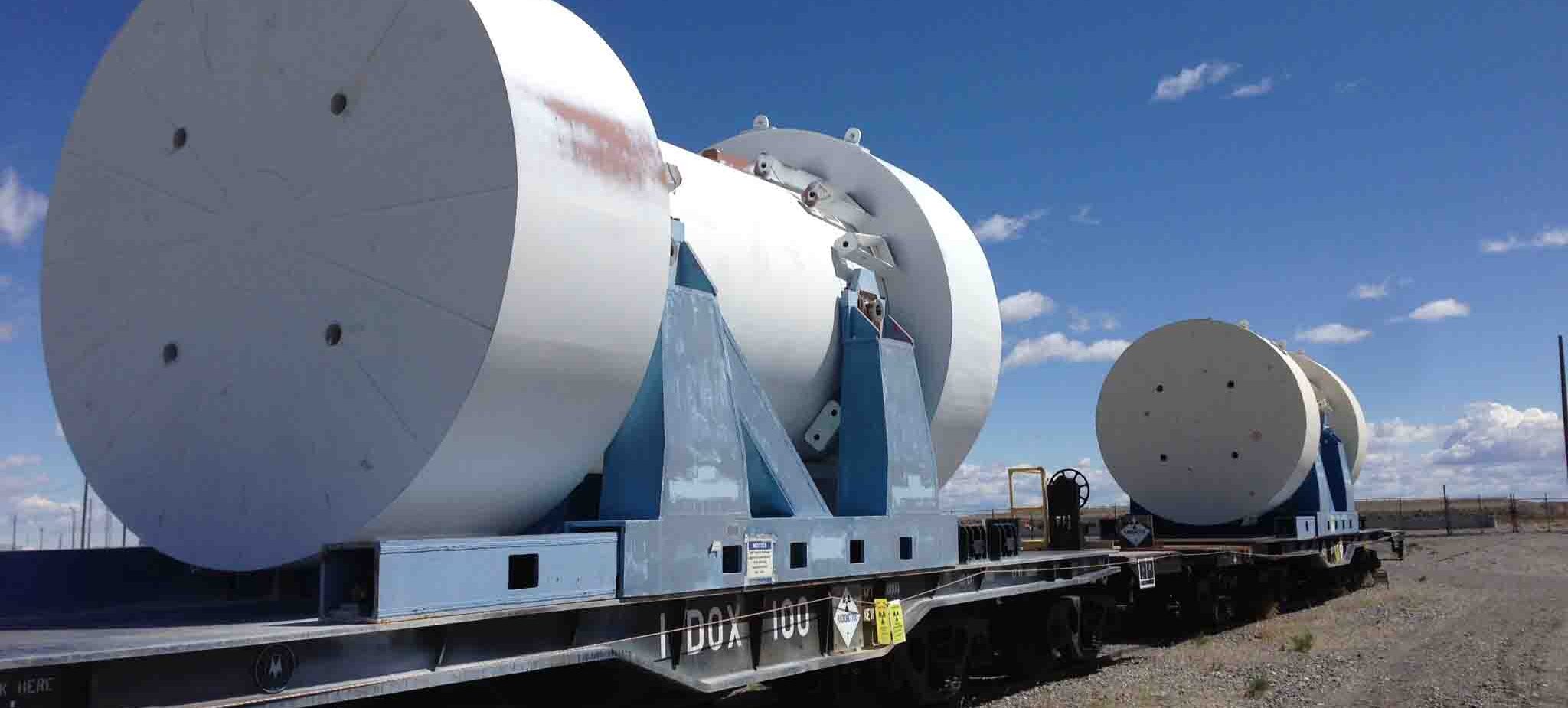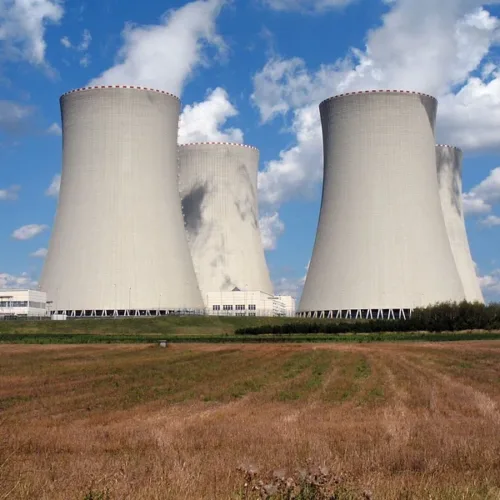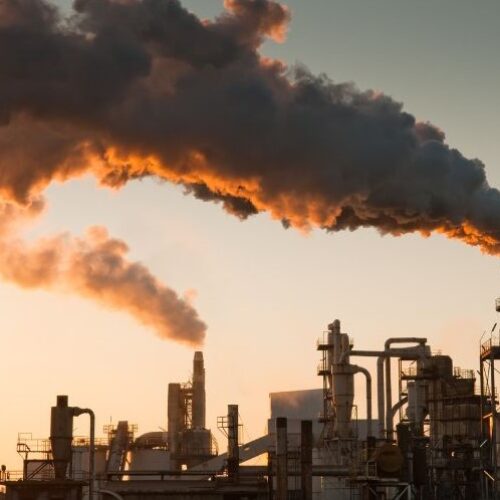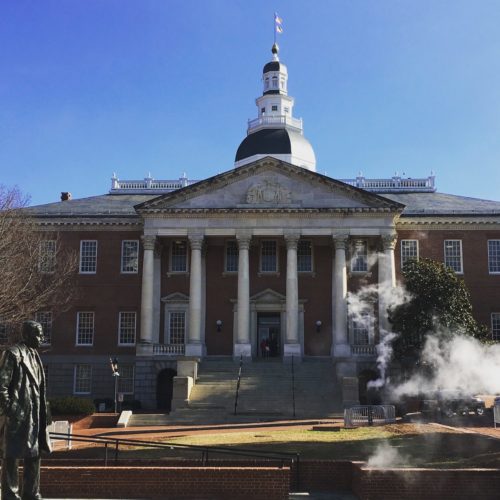Planning for the safe passage, and storage, of the region’s nuclear waste
This article appears in the 2019-2020 edition of CSG East’s Perspectives Magazine.

A cask carrying spent nuclear fuel from the West Valley Demonstration Plant in New York state to Idaho National Laboratory. Credit: U.S. Department of Energy
Last October, more than two dozen northeastern state and tribal leaders gathered in New Mexico to discuss a plan that could represent a near-term solution to a protracted environmental challenge: finding a home for the nation’s nuclear waste.
The group met with an official from Lea County, New Mexico, which has offered to host an interim spent fuel storage site proposed by Holtec International, a private U.S. company, in the New Mexican desert, some 35 miles outside of Carlsbad. If the project receives federal approval, the facility could store large quantities of spent fuel from sites across the country for decades to come.
The visit was sponsored by CSG/ERC’s affiliate organization, the Northeast High-Level Radioactive Waste Transportation Project, which is keeping a close watch on the Holtec proposal and a similar one located nearby, on the Texas border. If and when officials designate an interim storage site or a long-term repository, the organization will play a critical coordinating role.
“We don’t have a storage site right now, but site-specific planning is really important, because removing spent nuclear fuel from a plant is not easy — and it will take decades,” said Project Director Uldis Vanags. The organization collaborates with state and community leaders in the Northeast to develop plans to safely transport spent fuel along the region’s roads and railways.
In New Mexico, many local officials welcome the economic benefits that the county would reap from the Holtec proposal through tax revenues and jobs, but there is also opposition from some officials, residents, and environmental groups concerned about potential safety risks and legal issues associated with the transport of spent fuel.
A Long Impasse
Such concerns are not new. The challenge of finding a repository for the nation’s nuclear waste has existed since the first U.S. reactor went online more than six decades ago.
Legislation enacted in 1982 directed the U.S. Department of Energy (DOE) to investigate possible long-term storage sites for the nation’s spent nuclear fuel and high-level waste. Five years later, the government identified Yucca Mountain in Nevada as a potential repository, but the project was canceled by the Barack Obama administration in 2009 after prolonged legal challenges. Since then, there has been no agreement between Congress and the administration on a path forward.
Meanwhile, the waste continues to proliferate. U.S. commercial reactors have produced nearly 80,000 metric tons of waste, enough to fill a football field 20 meters deep. Currently, the spent fuel is stored in pools or dry casks in 80 sites across 35 states. The waste is located at operating reactors and at plants that have shut down, have been decommissioned, and no longer even have a reactor — all that’s left is the spent fuel. There is also high-level waste left over from the nuclear weapons program in need of a permanent storage site.
As the waste grows, the expense of storing it rises, too. Utilities are suing the DOE for the cost of stockpiling the waste at their reactors since 1998, the year that the department defaulted on a contract to begin removing it from plants nationwide. The federal government had already paid out more than $6 billion in settlements and court judgments as of the end of fiscal year 2016, according to the U.S. Government Accountability Office, and that expense is expected to cost $500 million a year going forward.
Even if Yucca Mountain were back on the table, it would be decades before shipments could begin, said Vanags. And if the project remains dead, he estimates that it would take 40 years to identify a new repository and begin sending waste there. Having an interim storage site is considered essential.

Members of the Northeast High-Level Radioactive Waste Transportation Project during a tour of the U.S. Department of Energy Waste Isolation Pilot Plant in Carlsbad, New Mexico.
Credit: Uldis Vanags
The Importance of Planning
Vanags and his colleagues regularly meet with community leaders in the Northeast who would be responsible for overseeing waste shipments in their jurisdictions, including state and tribal leaders, local officials, public safety experts, and first responders.
Together with DOE officials, they assess the infrastructure around plants to identify railroads, highways, bridges, barge inlets, and other routes that could be used during the transport of spent nuclear fuel from the sites.
Planning is important because in many cases, much of the infrastructure around the plants has changed since they were built four or five decades ago. For example, officials assess whether existing roads can handle heavy-haul trucks carrying casks that can weigh up to 480,000 pounds. If the plan is to put some of the casks on barges, they need to determine if the waterway needs dredging.
“If there’s dredging required, that’s a complex deal. The permits that would be needed can take years,” said Vanags.
Sometimes roads have been removed to make way for new development, and in many areas, the population has swelled. Earlier this year, the group visited the Oyster Creek plant, located on the shore of Barnegat Bay, near Long Beach Island, New Jersey, a popular summer vacation spot. The plant shut down in September 2018. Any waste shipments from the plant would need to halt during the summer months to avoid backing up roads already busy with beachgoers, said Vanags.
“These are all the things that are evaluated so that when a storage site becomes available, community leaders will have all the information they need to begin safe shipments,” Vanags said.
The group also met with the chief selectman of Plymouth, Massachusetts, and briefed him on their planning efforts for the eventual transport of spent fuel from the Pilgrim Nuclear Power Station, which shut down in May 2019. The group was invited to return in 2020 to educate the public about its work.
In preparation for the eventual rail transport of high-level waste, the Department of Energy is designing and testing a special rail car, called Atlas, that can carry massively heavy casks filled with spent fuel. Atlas will be built to the same specification that is currently used by the U.S. Navy for transporting spent fuel from nuclear-powered naval vessels. A prototype is currently undergoing testing, and the DOE is working with states and tribes to develop an inspection protocol for it, said Vanags.
Holtec’s proposed interim storage facility in New Mexico is currently under review by the Nuclear Regulatory Commission, with a decision expected next year. If the project is approved, operations could begin as early as 2023.





